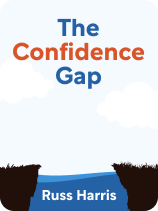

This article is an excerpt from the Shortform book guide to "The Confidence Gap" by Russ Harris. Shortform has the world's best summaries and analyses of books you should be reading.
Like this article? Sign up for a free trial here.
Looking for an overview of The Confidence Gap by Russ Harris? What does Harris say about building confidence? What advice is most important?
Being bombarded by negative thoughts or feeling that you’re incapable of accomplishing anything is one way psychotherapist Russ Harris says you’re living in the confidence gap. Harris claims that you’ll never be able to rid yourself entirely of your fears, but you can change how you react to them.
Read on for an overview of Russ Harris’s The Confidence Gap to learn his advice for bridging the gap.
The Confidence Gap Book Overview
In psychotherapist Russ Harris’s The Confidence Gap, Harris provides an approach to dealing effectively with the negative, limiting thoughts and fears that prevent you from achieving your goals. Rather than trying to speak to, tamp down, or ignore negative thoughts—all ineffective methods—Harris recommends you relate differently to your thoughts. This will allow you to pursue your goals without your thoughts interfering with your efforts.
Harris is a trainer in Acceptance and Commitment Therapy (ACT) and has held workshops on this approach all over the world. He’s also authored several other books, including the best-selling The Happiness Trap. The Confidence Gap is for people who struggle to carry out their life goals and seek to change their thinking to be more empowering.
In this overview of the book, we’ll explain how Russ Harris defines the confidence gap and how relating to your thoughts differently is the only way to bridge the gap.
How Does Harris Define the Confidence Gap?
According to Russ Harris, the confidence gap is the misconception that you can only live your life in a rich and fulfilling way—doing the activities, meeting the people, and gaining the skills that matter to you—once you become confident.
For instance, you might want to try stand-up comedy but believe you can’t sign up for an open mic night until you feel confident about your abilities.
(Shortform note: In You Are a Badass, Jen Sincero contends that the reason people don’t go for the things they want is that their egos, which feel undeserving of success and happiness, prevent them from doing so. Sincero would likely echo Harris by saying that you can’t wait around for your ego to develop confidence and self-love before you pursue your goals.)
The Problem With Waiting for Confidence: It Will Never Come
However, if you wait for confidence to naturally arise, you’ll wait forever and never be able to live the rich life you want, claims Harris. This is because you can’t get rid of the negative thoughts and feelings that stymie your confidence—especially the feeling of fear. Fear is an instinct that serves an important evolutionary purpose. Fear and negative thinking make you attuned to dangers around you. However, fear also holds you back from confidently doing the things you want to.
For instance, if you wait until you stop feeling nervous about doing stand-up before you sign up for an open mic night, you’ll likely never do it because you’ll never stop feeling nervous.
(Shortform note: In Big Magic, Elizabeth Gilbert echoes Harris’s belief that fear is unavoidable and also an innate product of our need to survive. However, she adds the idea that fear isn’t useful in many realms of life—like in the creative realm, which has nothing to do with survival. Harris doesn’t directly discuss when fear is and isn’t useful. He does believe that you can harness your fear to pursue your goals with more vigor, as we’ll see later on. However, it might be worth borrowing a page from Gilbert’s book and asking yourself if harnessing your fear will be useful in a given situation: Harnessing it might not always be the right move.)
Russ Harris adds that, to bridge the confidence gap, there are specific negative thoughts and fears you should recognize because they undermine your confidence:
- “I can’t meet these expectations.” Unsatisfiable expectations: You expect the impossible of yourself and thus don’t believe you can achieve them.
- “I’m no good.” You think negatively about yourself and your abilities.
- “I’m afraid, so I won’t do it.” You try desperately to avoid the feeling of fear, which makes the fear loom larger in your mind. (For instance, if you fear and desperately avoid public speaking, the act of public speaking will only become more terrifying.)
- “I don’t have the skills.” If you don’t yet have the skills or the experience required to do something well, you won’t be confident about doing it.
| Negative Thoughts About What Others Think of You Harris’s list of specific negative thoughts revolves around thoughts about your own abilities: how unskilled, unworthy, incapable, and afraid you are. But others might add another negative thought to this list that doesn’t center on your abilities: negative thoughts about what others think of you. In You Are a Badass, Jen Sincero argues that many people worry excessively about what others will think of them, which prevents them from pursuing audacious or unexpected goals. Sincero adds that such worries, like fear, have an evolutionary foundation: They make us more inclined to submit to the will of a group because we need its protection to survive. However, Harris might contend that worrying about what others think of you is a form of fear, which he alludes to in the above list: You fear the judgment of others and therefore opt out of activities that would otherwise fulfill you. What’s more, while Sincero provides methods to stop caring about what others think of you, Harris might say that it’s impossible to get rid of such worries because they’re wired into our brains. Instead, he’d likely recommend the technique below to relate more elegantly to your fears about how others perceive you. |
Bridging the Confidence Gap: Relate Skillfully to Negative Thoughts and Fears
Because you’ll never magically gain confidence, lose your negative thoughts, and banish all fears to pursue your goals, the better route to doing what you want in life is to relate to inevitable negative thoughts and fears differently.
Russ Harris explains that rather than either pushing bad feelings and thoughts away, “treating” them with positive thoughts, or just waiting for them to vanish on their own (all approaches that won’t give you long-term confidence), you should develop a different perspective on the thoughts and fears to bridge the confidence gap.
(Shortform note: One author who does feel that you can eliminate negative thoughts is Maxwell Maltz, who wrote Psycho-Cybernetics in 1960. He asserts that if you can stop listening to and believing negative thoughts, you’ll stop perpetuating a negative feedback loop, in which you act on bad feelings and therefore experience bad outcomes, which feed back into bad feelings. Maltz provides two methods for banishing negative thoughts, including paying attention only to the facts of a situation, rather than your feelings about it.)
This lets you do things that require confidence without having to wait endlessly for that confidence to arrive. If your dream is to do stand-up, for example, you can go out and do it without waiting for the confidence to miraculously show up.
The bonus is that when you take the actions that require confidence, you become better at those actions and thus become confident in doing them. For instance, when you attend open mic nights, you inevitably become better at stand-up, and that improvement gives you confidence.
(Shortform note: In The Confidence Code, Katty Kay and Claire Shipman agree with Harris that taking the actions of confidence precedes the feeling of confidence. However, they disagree with him that you need to relate to thoughts and fears before you can take action. Instead, they recommend just doing the action, especially if it’s a high-risk one. But if performing a high-risk action right away is too scary, they also advise building up to a high-risk action by performing lower-risk actions first. In this way, they do offer a preparational action, like Harris’s preparational mental work, that lets you take action.)

———End of Preview———
Like what you just read? Read the rest of the world's best book summary and analysis of Russ Harris's "The Confidence Gap" at Shortform.
Here's what you'll find in our full The Confidence Gap summary:
- How negative, limiting thoughts and fears prevent you from achieving your goals
- Why trying to ignore negative thoughts doesn't work
- The three steps to detach yourself from your negative thoughts






